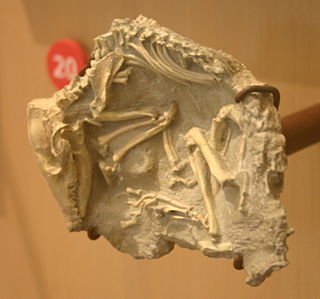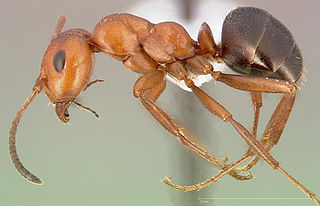
Convolvulaceae, commonly called the bindweeds or morning glories, is a family of about 60 genera and more than 1,650 species. These species are primarily herbaceous vines, but also include trees, shrubs and herbs. The tubers of several species are edible, the best known of which is the sweet potato.

The Integrated Taxonomic Information System (ITIS) is an American partnership of federal agencies designed to provide consistent and reliable information on the taxonomy of biological species. ITIS was originally formed in 1996 as an interagency group within the US federal government, involving several US federal agencies, and has now become an international body, with Canadian and Mexican government agencies participating. The database draws from a large community of taxonomic experts. Primary content staff are housed at the Smithsonian National Museum of Natural History and IT services are provided by a US Geological Survey facility in Denver. The primary focus of ITIS is North American species, but many biological groups exist worldwide and ITIS collaborates with other agencies to increase its global coverage.

Leptictidium is an extinct genus of small mammals that were likely bipedal. Comprising eight species, they resembled today's bilbies, bandicoots, and elephant shrews, and occupied a similar niche. They are especially interesting for their combination of characteristics typical of primitive eutherians with highly specialized adaptations, such as powerful hind legs and a long tail which aided in locomotion. They were omnivorous, their diet a combination of insects, lizards, frogs, and small mammals. Leptictidium and other leptictids are not placentals, but are non-placental eutherians, although they are closely related to placental eutherians. They appeared in the Lower Eocene, a time of warm temperatures and high humidity, roughly fifty million years ago. Although they were widespread throughout Europe, they became extinct around thirty-five million years ago with no descendants, as they were adapted to live in forest ecosystems and were unable to adapt to the open plains of the Oligocene.

Glaresis is a genus of beetles, sometimes called "Enigmatic scarab beetles", in its own family, the Glaresidae. It is closely related to, and was formerly included in, the family Scarabaeidae. Although its members occur in arid and sandy areas worldwide, only the nocturnal adults have ever been collected, and both the larvae and biology of Glaresis are as yet unknown. Due to their narrow habitat associations, a great number of these species occur in extremely limited geographic areas, and are accordingly imperiled by habitat destruction.

Simoedosaurus is an extinct reptile known from the Paleocene of North America, Europe and western Asia, and a member of the Choristodera, a group of aquatic reptiles that lived in the Northern Hemisphere from the Jurassic to the early Cenozoic.

Leptictis is an extinct genus of leptictid non-placental eutherian mammal known from the Late Eocene to Early Oligocene of North America. The type species, L. haydeni, was named in 1868 by Joseph Leidy in honour of Ferdinand Vandeveer Hayden. L. dakotensis was also named by Leidy in 1868, but he originally named it as a separate genus, Ictops, which is now seen as the same animal as Lepticitis. Since then, six other species have been named. The hind limbs are proportionally elongated compared to their forelimbs similar to elephant shrews, though to a lesser degree than Leptictidium, and it is suggested that they were capable of rapid bursts of quadrupedal locomotion, unlike the bipedal locomotion suggested for Leptictidium. The forelimbs were likely used for digging.

Sequoia is a genus of redwood coniferous trees in the subfamily Sequoioideae of the family Cupressaceae. The only extant species of the genus is Sequoia sempervirens in the Northern California coastal forests ecoregion of Northern California and Southwestern Oregon in the United States. The two other genera in the subfamily Sequoioideae, Sequoiadendron and Metasequoia, are closely related to Sequoia. It includes the tallest trees, as well as the heaviest, in the world.

Leptostylus transversus is a species of longhorn beetles of the subfamily Lamiinae. It was described by Gyllenhal in 1817.

Neophrontops is an extinct genus of Old World vulture. Despite being taxonomically an "Old World" vulture, specifically a member of the subfamily Gypaetinae, it was native to North America, with six species having been named, spanning from the Early Miocene to the Late Pleistocene. All except N. americanus are only known from fragmentary remains, though well preserved remains are known from the late Middle-Late Pleistocene aged La Brea Tar Pits of Southern California.

Elmidae, commonly known as riffle beetles, is a family of beetles in the superfamily Byrrhoidea described by John Curtis in 1830. Both adults and larvae are usually aquatic, living under rocks in fast-flowing shallow areas of streams, such as riffles, feeding on algae and biofilms. There are more than 150 genera and 1,500 described species in Elmidae. The oldest record of the group is Cretohypsilara from the Cenomanian aged Burmese amber.
Megachile dakotensis is a species of bee in the family Megachilidae that inhabits the Midwestern United States.

The Globidensini or Globidentatini are a tribe of mosasaurine mosasaurs, a diverse group of Late Cretaceous marine squamates. Members of the tribe, known as "globidensins" or "globidensine mosasaurs", have been recovered from North America, Europe, Africa and Asia. The tribe contains the genera Globidens, Carinodens, Igdamanosaurus, Harranasaurus and Xenodens. Features of the maxilla and digits make the placement of Carinodens and Xenodens in the tribe uncertain; some researchers have suggested that they may be more appropriately placed in the Mosasaurini.

Corixinae is a subfamily of aquatic bugs in the family Corixidae. There are at least 130 described species in Corixinae.
Cenocorixa is a genus of water boatmen in the family Corixidae. There are about 12 described species in Cenocorixa.
Aradus vadosus is a species of flat bug in the family Aradidae. It is found in North America.

Formica dakotensis is a species of ant in the family Formicidae.
Osmia dakotensis is a species of bee in the family Megachilidae. It is found in North America.

Kosmodraco is a genus of large bodied choristodere from the Paleocene of North America. Originally described as species of the closely related Simoedosaurus, it was found to represent a distinct genus in 2022. Multiple fossil skulls show a relatively short and robust snout and a skull that is considerably wider behind the eyes. Two species are currently recognized, K. dakotensis and K. magnicornis.













